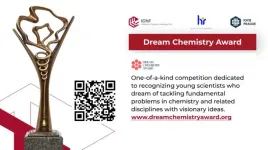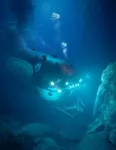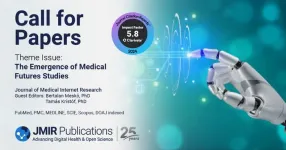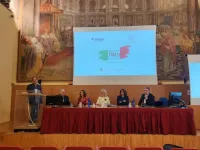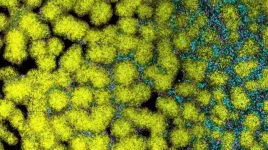(Press-News.org) Dusty ice exposed at the surface of Mars could provide the conditions necessary for the presence of photosynthetic life, according to a modelling study. The findings, published in Communications Earth & Environment, suggest that ice deposits located in the planet’s mid-latitudes should be a key location in any search for life on Mars.
High levels of harmful ultraviolet radiation from the Sun make current life on the surface of Mars almost certainly impossible. However, a sufficiently thick layer of ice can absorb this radiation and could protect cells living below its surface. Any life in these conditions would need to be in a so-called radiative habitable zone — shallow enough to receive enough visible light for photosynthesis, but deep enough to be protected from the ultraviolet radiation.
Aditya Khuller and colleagues calculated whether such a radiative habitable zone could exist in ice with the dust content level and structure of the ice observed on Mars. They found that very dusty ice would block too much sunlight, but that in ice containing 0.01–0.1% dust, a habitable region could potentially exist at depths between 5 and 38 centimetres (depending on the size and purity of the ice crystals). In cleaner ice, a larger habitable zone could exist between 2.15 and 3.10 metres deep. The authors explain that dust particles within the ice could cause occasional localised melting at depths of up to approximately 1.5 metres, providing the liquid water necessary for any photosynthetic life to survive. They suggest that the polar regions on Mars would be too cold for this process, but that subsurface melting could occur in mid-latitude areas (between approximately 30 and 50 degrees latitude).
The authors caution that the potential existence of theoretically habitable zones does not mean that photosynthetic life is, or has ever been, present on Mars. However, it does suggest that the few instances of exposed ice in the Martian mid-latitudes could be key areas for future searches for life to focus on.
END
Astrobiology: Potential microbial habitats in Martian ice
2024-10-17
ELSE PRESS RELEASES FROM THIS DATE:
IChF tribute to the chemical imagination: the Dream Chemistry Award
2024-10-17
The Dream Chemistry Award (DCA) is a one-of-a-kind competition dedicated to recognizing young scientists who dream of tackling fundamental problems in chemistry and related disciplines with visionary ideas. Established in 2013 by the Institute of Physical Chemistry of the Polish Academy of Sciences (IChF), the award aims to support emerging talents in realizing their scientific dreams. Since 2017, it has been organized jointly with the Institute of Organic Chemistry and Biochemistry of the Czech Academy of Sciences (IOCB Prague), with the finals alternating between Prague and Warsaw.
The Dream Chemistry Award empowers those pursuing ...
New tool helps analyze pilot performance and mental workload in augmented reality
2024-10-17
In the high-stakes world of aviation, a pilot's ability to perform under stress can mean the difference between a safe flight and disaster. Comprehensive and precise training is crucial to equip pilots with the skills needed to handle these challenging situations.
Pilot trainers rely on augmented reality (AR) systems for teaching, by guiding pilots through various scenarios so they learn appropriate actions. But those systems work best when they are tailored to the mental states of the individual subject.
Enter HuBar, a novel visual analytics tool designed to summarize and compare task performance ...
Researchers advance ideas on abiotic organic synthesis
2024-10-17
Recently, a Chinese research team reported the discovery of abiotic organic compounds in the oceanic crust of the Southwest Indian Ridge and proposed a molecular mechanism for organic condensation.
This breakthrough followed the team’s discovery of nanoscale abiotic organic matter in mantle rocks from the Yap Trench in 2021. It represents a significant advance in research on deep-sea carbon cycling and the origin of life, shedding light on key pathways for abiotic organic synthesis in nature.
The scientists published their findings in the Proceedings ...
Visible light energy yields two-for-one deal when added to CO2 recycling process
2024-10-17
CHAMPAIGN, Ill. — By combining visible light and electrochemistry, researchers have enhanced the conversion of carbon dioxide into valuable products and stumbled upon a surprising discovery. The team found that visible light significantly improved an important chemical attribute called selectivity, opening new avenues not only for CO2 conversion but also for many other chemical reactions used in catalysis research and chemical manufacturing.
One way that chemists recycle CO2 into valuable products is through a process called electrochemical reduction, where a stream of CO2 gas moves through an electrolysis cell that breaks the CO2 and water ...
Search continues for a treatment that reduces long COVID symptoms
2024-10-17
The first randomized, placebo-controlled clinical trial evaluating the impact of therapeutic monoclonal antibodies on the risk of developing long COVID was led by researchers at Weill Cornell Medicine. The study, published Sept. 1 in eClinicalMedicine, details an international, multicenter phase 2/3 clinical trial that found a combination of amubarvimab and romlusevimab did not reduce the occurrence of long COVID symptoms.
Lasting weeks or even months after SARS-CoV-2 infection, long COVID is characterized by a variety of symptoms that affect each person differently. These include extreme fatigue, difficulty concentrating, ...
The Journal of Medical Internet Research theme issue call for papers: The emergence of medical futures studies
2024-10-17
(Toronto, October 17, 2024) JMIR Publications invites submissions to a new theme issue titled “The Emergence of Medical Futures Studies” in the Journal of Medical Internet Research, the leading peer-reviewed journal for digital medicine and health and health care in the Internet age, indexed in PubMed, PMC, MEDLINE, SCIE, Scopus and DOAJ.
The rapid progress of technology in health care, combined with significant cultural shifts toward digital health and the urgent need for preparedness, highlighted by events such as the COVID-19 pandemic and climate change, have brought about an increased emphasis ...
License to chill: Bond shows ‘regressive nostalgia’ can freeze a brand's future
2024-10-17
Super-spy James Bond is a prime example of ‘regressive nostalgia’ highlighting how certain consumer groups cling to idealised past versions of brands and resist attempts to move with the times, a new study reveals.
Researchers examined the James Bond movie franchise - a cultural icon for over 70 years - and discovered that some ‘super-consumers’ react negatively to modern portrayals of the fictional British secret agent that reflect contemporary societal values.
Whilst loyal to the brand, these consumers prefer traditional, more exclusionary, versions of Bond which most closely follow author Ian Fleming’s original 1950s and 1960s vision – ...
Researchers from Brazil and Italy search industrial waste for new Alzheimer’s drugs
2024-10-17
A self-proclaimed Brazil-Italy collaboration enthusiast, researcher Laura Bolognesi created the B2AlzD2 Joint Lab at the Department of Pharmacy and Biotechnology of the Università di Bologna (UNIBO), the first Brazil-Bologna joint laboratory dedicated to the development of new drugs for the treatment of Alzheimer’s disease. The partners include scientists from four Brazilian universities: the Federal University of Rio de Janeiro (UFRJ), the University of Brasília (UnB), the University of São Paulo (USP Ribeirão Preto) and the Federal University of Minas Gerais (UFMG).
One of the laboratory’s ongoing ...
BU, Boston Medical Center researchers join forces with GSK to fight lung diseases
2024-10-17
(Boston)—Researchers from the Center for Regenerative Medicine (CReM) at Boston University and Boston Medical Center (BMC) have announced a new collaboration with the global biopharma company GSK to advance innovative research focused on developing cutting-edge models to study and treat lung diseases like pulmonary fibrosis.
Pulmonary fibrosis, including its most common form, idiopathic pulmonary fibrosis (IPF), is a progressive and life-threatening condition that results in scarring of the lungs, making it increasingly difficult for patients to breathe. ...
Bacteria thrive by playing nice before going their own way
2024-10-17
Biofilms — slimy communities of bacteria — grow on all sorts of surfaces: from glaciers and hot springs to plant roots, your bathtub and fridge, wounds, and medical devices such as catheters. Most biofilms are composed of multiple bacterial species, but how these species manage to live together is unclear.
A new study by Dartmouth scientists in Current Biology uses experiments and modeling to delve into how three species of biofilm bacteria coexist — and when they move out on their own. One species, Pseudomonas aeruginosa, a verstaile pathogen known to be antibiotic resistant, dominated ...
